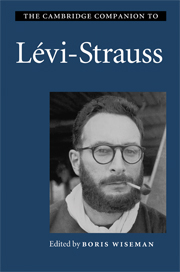Book contents
- Frontmatter
- Introduction
- Part I: Society and culture
- Part II: Myth and mind
- 5 The two natures of Lévi-Strauss
- 6 On anthropological knowledge
- 7 The limits of classification: Claude Lévi-Strauss and Mary Douglas
- 8 The local and the universal
- 9 Lévi-Strauss and the question of symbolism
- 10 Claude Lévi-Strauss’s theoretical and actual approaches to myth
- Part III: Language and alterity
- Part IV: Literature and aesthetics
- Bibliography of works by Claude Lévi-Strauss
- Index
9 - Lévi-Strauss and the question of symbolism
from Part II: - Myth and mind
Published online by Cambridge University Press: 28 January 2010
- Frontmatter
- Introduction
- Part I: Society and culture
- Part II: Myth and mind
- 5 The two natures of Lévi-Strauss
- 6 On anthropological knowledge
- 7 The limits of classification: Claude Lévi-Strauss and Mary Douglas
- 8 The local and the universal
- 9 Lévi-Strauss and the question of symbolism
- 10 Claude Lévi-Strauss’s theoretical and actual approaches to myth
- Part III: Language and alterity
- Part IV: Literature and aesthetics
- Bibliography of works by Claude Lévi-Strauss
- Index
Summary
Innovative thinking always operates on the uncertain border between light and darkness. On the side of light, it formulates new, explicit, clearly defined concepts, putting them forward for debate, hoping to convince while taking the risk of being contradicted or even rejected. On the side of darkness, it draws from a reserve of notions which lies within of the realm of the commonly shared views of an epoch or an established discipline and its traditions. Lévi-Strauss's thinking about the concept of symbolism illustrates this in exemplary fashion. This concept derives from a long philosophical and hermeneutic history. At the turn of the twentieth century, the most prominent figures of British religious anthropology - Frazer, Robertson-Smith - and those of the French school of sociology - Durkheim, Mauss - made it one of the major concepts of their theoretical work. From his earliest works, Lévi- Strauss has proposed to use it in a specific way and has elaborated, in this connection, original positions. He writes in 1945: 'No social phenomenon may be explained, and the existence of culture itself is unintelligible, if symbolism is not set up as an a priori requirement of sociological thought' (1945a: 517-18). He also adds: 'Sociology cannot explain the genesis of symbolic thought, but has just to take it for granted in man' (1945a: 518). A few years later in the Introduction to the Work of Marcel Mauss, he specifies: 'Any culture can be considered as a combination of symbolic systems headed by language, the matrimonial rules, the economic relations, art, science and religion' (1950a; 1987a: 16).
- Type
- Chapter
- Information
- The Cambridge Companion to Lévi-Strauss , pp. 177 - 195Publisher: Cambridge University PressPrint publication year: 2009
- 2
- Cited by



